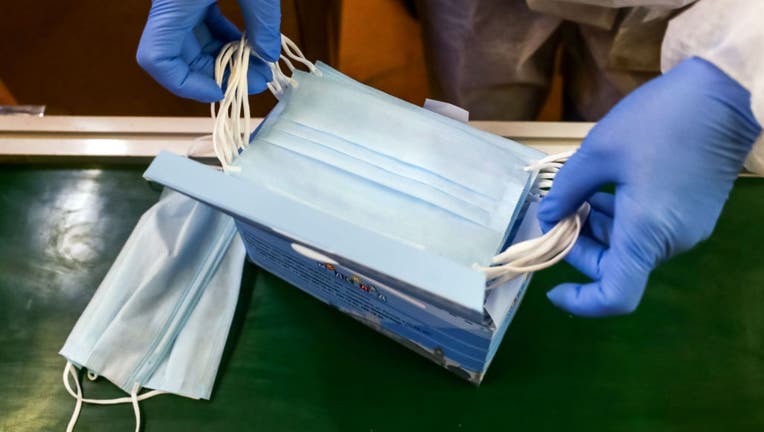What type of face mask is best amid the recent omicron surge

FILE - A face mask production line at an OOO Medsklad production facility at BEMZ Berdsk Electromechanical Plant in the town of Berdsk, Novosibirsk Region.
LOS ANGELES - As the nation’s medical infrastructure continues to be inundated with COVID-19 cases amid the spread of the omicron variant, it’s extremely critical to mask up now more than ever.
Hospitals across the U.S. are feeling the wrath of the omicron variant and getting thrown into disarray that is different from earlier COVID-19 surges.
This time, they are dealing with serious staff shortages because so many workers are getting sick. People are showing up at emergency rooms in large numbers in hopes of getting tested for COVID-19. And a surprising number of patients are testing positive for the virus while in the hospital for other reasons. At the same time, hospitals say the patients aren’t as sick as those who came in during the last surge.
Amidst the ongoing confusion, vaccination efforts across the nation have hit a wall while health experts are pleading with Americans to get their shots.
Though COVID-19 vaccines greatly reduce the chance of severe illness and death and remain effective against variants, some experts said wearing a mask is a reasonable precaution since it's still possible to get infected.
Masking could also help prevent the spread of the virus to children too young for vaccination and people with weak immune systems.
During the onset of the pandemic, thousands of individuals and organizations answered the call to produce homemade masks amid serious shortages of medical supplies, but researchers say that while masks are important in fighting the spread of the disease, the material used to make them matters.
What’s the latest advice on the type of mask I should wear?
It depends on your situation, but health officials say it should cover your nose and mouth, and fit snugly so there aren’t any gaps on the sides of your face.
The U.S. Centers for Disease Control and Prevention also says to pick masks with two or more layers and a nose wire to prevent air from leaking out the top. It suggests holding your mask up to check if it blocks light, which means the fabric will probably filter out more particles.
If you want added protection, experts also suggest wearing two masks or pairing them with a mask fitter to ensure they don’t leave any gaps.
It’s also important to find a mask that’s comfortable so you actually wear it, says Laura Kwong, an assistant professor in environmental health sciences at the University of California, Berkeley.
If supplies are available, people can opt for disposable N95 masks for personal use, the CDC says in updated guidance. Such masks are considered most effective at blocking virus particles. The agency had previously said N95 masks should be reserved for health care workers, but supplies have since expanded.
What’s the best type of mask design?
In 2020, researchers at the Wake Forest Baptist Medical Center evaluated approximately 400 masks made by community volunteers in order to find which, if any, masks worked as well as N95 respirators or any other medical-grade surgical masks.
According to researchers, the best design was that of a double-layer mask made of heavyweight "quilter’s cotton," consisting of a thread count of 180 or more. A double-layer mask with a simple cotton outer layer and inner layer of flannel also performed well.
The inferior masks consisted of single-layer or double-layer designs made of lightweight cotton.
"As important as this information is for hospitals, it is also important for people who want to make masks for their own use," said Scott Segal, M.D., chair of anesthesiology at Wake Forest Baptist. "We don’t want people to think that just any piece of cloth is good enough and have a false sense of security."
Do masks actually work?
While some masks offer more protection than others, something is still better than nothing.
Dr. Richard Davis, who is the clinical microbiology lab director at Providence Sacred Heart Medical Center in Spokane, Washington, tweeted a series of photos during the onset of the pandemic that showcased two demonstrations aimed at understanding how effective face masks are at blocking respiratory droplets from an individual’s mouth, while also illustrating the importance of social distancing.
Using a standard triple-layer hospital issue surgical mask, Davis sneezed, sang, talked and coughed toward an agar culture plate with and without a mask.
Agar culture plates are Petri dishes filled with agar, a gelatinous substance obtained from red algea to culture, or help multiply microorganisms. After performing each action, Davis said bacteria colonies formed in the dishes where the respiratory droplets emitted from his mouth landed.
"Bacteria colonies show where droplets landed. A mask blocks virtually all of them," Davis wrote in a caption for the post.
This story was reported from Los Angeles. The Associated Press contributed.

